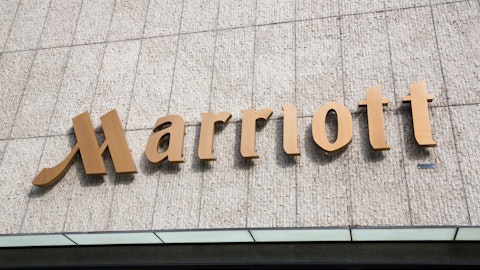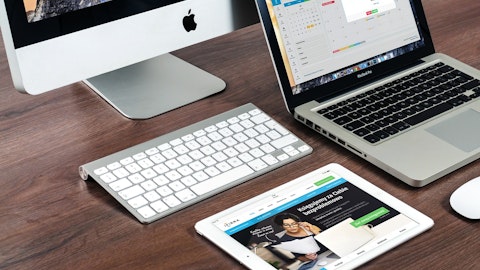And so the question would be how high did those grow if they do grow into next year and what sort of pressure. The other factor to consider is that, generally speaking, our receivable balance is higher than it used to be over the last several years. And so a higher receivable balance and interest income obviously can offset some of those pressures as well. So those are a couple of the bigger things we’re trying to understand as we think about the credit card specifically. And as you mentioned, again, for next year, the other puts and takes, again, we’re not guiding next year, but that credit card pressure and the membership benefit is one of the bigger factors we’re trying to understand. Another one that I would call out would be — we know that we’re going to likely have to add STI expense back in as we’re — we’ve lowered the expense this year as we reset STI in the coming year to roughly $85 million that we would likely add back.
Clearly, where the industry is a question as well to the extent that sales are flat or up, it helps relieve some of the pressure of some fixed costs. Clearly, the level of pressure matters quite a bit next year. If it’s a small increase, small decline, it’s less significant than is a bigger decline. So those are some of the bigger factors we’re trying to think through as we go into next year.
Chris Horvers: So that’s a perfect segue. On the SG&A side, Corie, I know you talked about your NPS scores with purchasing customers and what you’re seeing in the store, you’ve caught what feels like a lot of labor over the past few years or past couple of years. Are there any metrics that you’re seeing, whether it’s non-purchasing customers, like close rates versus people walking indoor that are concerning to you? And then as you think about ’24, given that you’ve comped negatively for this sustained period, is there just less flexibility to manage the labor component?
Corie Barry: So I alluded to NPS being one of the factors that we — you can imagine, there is a broad array of both operational and then more survey-based metrics that we’re looking at, everything from how fast can we do an in-store pick, how good is the curbside experience. We specifically talked about and we can see meaningful improvements year-over-year in product availability, in associate availability, in a variety of products and pricing, and those have continuously improved even as this year has gone on. And actually, we can also see some level of improvement in some of those through non-purchasers as well. So we’re watching both sides of this and that sequential improvement is happening across both purchasers and non-purchasers.
And yes, we’re watching close rate too, and the team is doing a really nice job measuring themselves and showing some progress against their close rate expectations as well. So we are — literally, we have the almost Rubik’s cube of operational and customer survey-based metrics so we can assess. I think what the team has done a really amazing job at is your point around flexibility. You talked about do you have less. Interestingly, now we have associates who can opt into and get certified in not just multiple areas of expertise within the store, but they can also get certified for operations roles and sales roles, and they can actually move between stores within their markets. And so we can flex not just against what’s the consumer demand at the highest level, we can actually flex within a market depending on how and where people are choosing to shop.
So I can even use an example like in the last week, we’ve seen a lot more people opting into in-store pickup and curbside and needing a bit more ship from store, and we can quickly then shift some of that labor into those areas, while still trying to strike the balance. We also talked about even moving some of the ship from store out of stores using those automated facilities so that when we do have labor in the stores, it’s more customer-facing. It’s facing more some of these key areas where we’re trying to deliver these experiences. So not perfect and certainly not going to be perfect every single day at every single location, but we really are working hard, and I give the team a great deal of credit for every day monitoring both the experiences and the operational metrics that will tell us whether or not we’re delivering.
Chris Horvers: Got it. Have a great Thanksgiving.
Corie Barry: Thanks, you too.
Operator: Your next question comes from the line of Peter Keith of Piper Sandler. Your line is open.
Peter Keith: Hey, thanks. Good morning everyone. Happy holidays. Nice to see the membership program changes coming a bit more accretive than initially guided. Could you help us unpack that a little bit in terms of the drivers, if it’s just removing the free installation or maybe that middle tier is trending a little more profitable than you thought. Maybe curious on what the uptick is from?
Matt Bilunas: Sure. The main drivers of the improvement from a rate perspective are — there’s basically four main areas. The first is the point change to the three My Best Buy program. The second would be just the growth in paid members over time and the recognition of those annual fees. The changes we made to the total tech program, moving it to Total, mainly came through with lowering the cost to fulfill as we removed the free installation that also was part of the 35 basis points, and the resumption of appliance at home theater installation, paid insulation is the other part of the number. The main drivers of it coming better than our expectations are around higher-than-expected paid installation volumes and then also lower-than-expected Best Buy claims and lower Apple premiums than we had expected.




